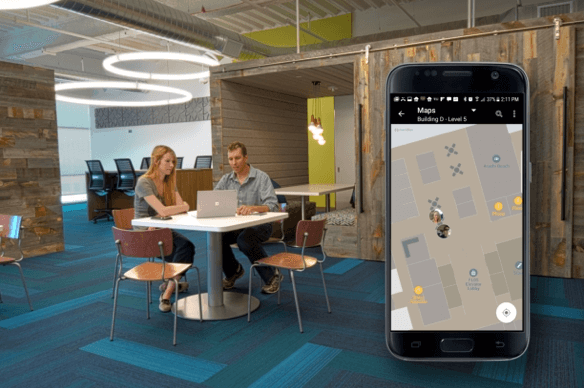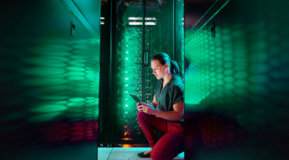Massive changes in enterprise technology and business processes are having a major impact on the nature and operation of the workplace. At the same time, we are in the midst of a profound demographic shift toward more and more Millennial and Gen Z workers. With mobile technology, the workplace can be anywhere. In a strong economy, there is fierce competition for talent and a laser focus on maximizing workforce productivity and loyalty.

As a result, workplaces are evolving to meet users' needs in a proactive way, rather than just being a "place to sit." Workplace technology and space design are working hand in hand more than ever before. This is nurturing a new spirit of collaboration among traditionally disparate IT, corporate real estate, and management stakeholders. Traditional office layouts have given way to vibrant collaborative spaces, creating environments where people innovate and thrive. And that appeals to the newest generation of workers, who have grown up in a culture of technology immersion and group collaboration.
A Successful Workplace Puts the Needs of End Users First
Putting the user at the center of new workplace design elevates the working experience and helps organizations achieve their goals of innovation, productivity, and cost savings. This approach creates a workplace that supports the array of activities that people do during the day, from heads-down work to ad-hoc collaborations. Technology is a key part of this approach, from the IT infrastructure all the way to end-user devices such as smartphones.
When designing a workplace, it's critical that key stakeholders work closely from the project outset, all the way to completion, rollout, and ongoing operation, to ensure that a great user experience is supported by great technology. End users should be intimately involved at all stages as well; without their buy-in, the most theoretically ideal approach can fail.
Applications, enabled by a smarter and more-connected workplace and workforce, are a key part of the picture. These applications, aided by an intelligent network, advanced sensors, and other infrastructure, can literally help each user throughout his or her day. Examples are advanced AV and collaboration technology in conference rooms; simpler methods for managing visitors; direction-finding within a facility; improved booking of conference rooms; and many others, some yet to be determined.
With this type of collaboration, workplace transformation can truly occur. At Aruba, a Hewlett Packard Enterprise company, we call this the Intelligent Edge, a set of modern digital experiences at the convergence of people, apps, and things.
When the workplace is everywhere, the IT infrastructure must be smarter, more capable, and more secure. The wireless and wired network must manage and secure many different types of devices, both devices associated with users and new kinds of devices like sensors. Any and all devices may be mobile and must be supported in a seamless, secure manner, so people have a consistently positive experience while security and other corporate policies are enforced. This approach allows end users to share contexts like each other's location, which leads to more efficient utilization of space and people's time. Advanced network analytics can provide true business insight, such as identifying popular and underutilized office spaces.
Modern Businesses Need to Focus on User Experiences
A great digital workplace combines great space design and great technology, with user experience at the core. But what does this feel like in real life, from the user's point of view? It's all about user experiences and making these experiences as seamless, efficient, and fulfilling as possible.

When enterprise-level advanced Wi-Fi is everywhere, people can work where and how they please. There are no dead spots in stairwells or at the far ends of hallways. There's plenty of Wi-Fi on the patio for a working lunch. People can start a Skype for Business session in their workspace, and if they move into a teaming room or conference space, the session moves to the big screen without pause.
A digital workplace eliminates small hassles and inconveniences. When visitors arrive, they sign on to get connected to the Wi-Fi, and the next time, they have connected automatically. People book conference rooms using a mobile app, eliminating those persistent complaints about the meeting rooms always being busy. Indoor location services help people find their way across campus and even find other people. High-value assets can be tracked and found quickly.
Technology is transforming facilities management by allowing greater control of temperature, lighting and other comfort factors, as well as saving on energy and other costs. Advanced analytics are helpful here as well. Low-cost sensors, massively deployed, give a granular picture that serves both end users and facilities management.
Finally, the digital workplace can help protect workers' safety and well-being, by providing better lighting and climate as well as enabling better emergency communications, registering employee safety, access control, and other aspects of corporate security. New technologies allow these enhancements to be offered in a seamless manner and don't add to the complexity of the user experience.
All in all, the digital workplace is a worthwhile investment for all stakeholders, and thus is becoming the norm, representing the level of corporate support desired by workers as well as a major source of motivation and productivity.
See Aruba on the Innovation Tours
Our vision of the new digital workplace will be on full display at CoRE Tech on November 14 to 15. The Real Estate Tech Innovation Tours give attendees a unique opportunity to visit innovative companies.
Aruba is pleased to open our doors to show our mobile-first digital workplace in action, alongside other innovative workplaces such as LinkedIn and Google. The tour highlights Aruba's flexible workspace, indoor location services, and integrations with building IoT solutions. Visitors will see intelligent collaboration tools, indoor wayfinding and asset tracking capabilities, space utilization analytics, smart furniture systems, and a location-enhanced real-time facility management system.
Join Us for an Expert Panel on Digital Workplaces
If you're at the show, don't miss the session, "The New Digital Workplace – Understanding Fads, Trends and Sustainable Expectations" on Wednesday, November 11 from 11:20am to 12:05pm in the Mission City Ballroom in the Santa Clara Convention Center. I'll be there in good company with other workplace thought leaders from Colliers, iOffice, Herman Miller, and Fidelity Investments. And I hope to see you there too.
If you can't make it to the show, you can still get a glimpse of the future. Watch the video: A look inside Aruba's own digital workplace.
Learn more about the Aruba Mobile First Platform.
Alan Ni is a director of solutions marketing at Aruba, a Hewlett Packard Enterprise company.




